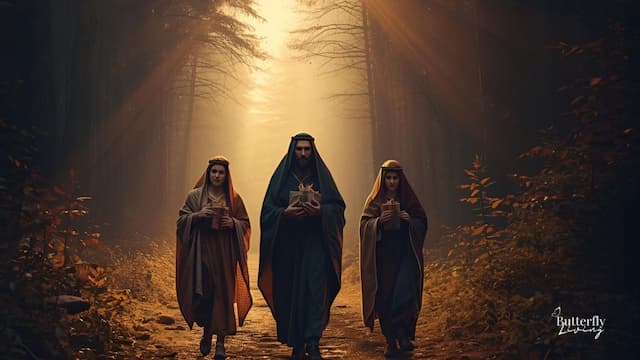How John introduces Christ (John 1)
With no nativity story, the opening of John’s Gospel is sometimes ignored at Christmas. But if Christmas is the coming of the Christ, well that’s what John’s Gospel is all about: these things are written so that you may believe Jesus is the Christ (John 20:31).
So, how does John introduce the Christ? What does John mean by describing Jesus as the Word? To hear these words afresh, let’s work backwards through John 1.
“Rabbi, you are the Son of God; you are the king of Israel.” That’s Nathanael’s declaration at the end of John 1 (verse 49). That’s where John is taking us.
“We have found the one Moses wrote about in the Law, and about whom the prophets also wrote — Jesus of Nazareth, the son of Joseph,” Andrew told his friends (verse 44). It’s not what Philip was expecting: “Nazareth! Can anything good come from there?” (verse 46).
“We have found the Messiah,” Andrew told Peter. John tells us that Messiah means anointed king (verse 41). How had Andrew found the king?
“Among you stands one you do not know … the straps of whose sandals I am not worthy to untie,” John the Baptizer declared (verses 26-27). The wilderness prophet was proclaiming the king who would remove the world’s rebellion against God’s kingship: “Look! The Lamb of God who takes away the sin of the world” (verse 29).
For 600 years, Jerusalem had no God-anointed king. What God had declared for them was not their experience. Now God’s promise had come: The Word became flesh and made his dwelling among us (verse 14).
The Word? Yes, there’s an authenticity to God. His truth is expressed in what he says. God had named David as the son to represent on earth the throne of his Father in the heavens (2 Samuel 7:14-16; Psalm 2:7). But David had fallen. They were serving foreign powers. Then, suddenly:
The Word became flesh and made his dwelling among us. We have seen his glory, the glory of the one and only Son, who came from the Father, full of grace and truth (verse 14).
Did you get that?
- God’s decree (the Word from heaven) was now physically present (enfleshed) in the world, as the heavenly sovereign dwelling (tabernacled) among them.
- The majesty (glory) of the heavenly king had come to earth in the Son. He was the full expression of the Father’s generous reign (grace), present in reality (in truth).
- The Son is the visible expression of God, in a way the world has ever seen or known before (verse 18).
God decreed, “Light!” for the world, but it has been a dark place. God’s decree was now shining into the world as the true light that gives light to everyone (verse 9).
Many of his own people did not recognize the Son whom the Father sent them, yet the Son has authority to share his regal sonship with all who trust his leadership. In him we are rebirthed as children in our Father’s family. His authority to rebirth humanity is not limited to flesh-and-blood relatives or the wishes of a human ruler: in the Son — the divine presence on earth — the human family was born of God (verses 12-13).
John describes the one who has this authority as the Word. The Christ is the expression of what God has always been, what God has always said.
John 1:1-5 (my translation)
1 In the beginning was the expression.
The expression was associated with God.
The expression was God.
2 This one was in the beginning associated with God.
3 Everything came through him.
Without him not a single thing came to be that has come to be.
4 In him was life, and the life was the light of humanity.
5 The light shines in the dark, and the dark doesn’t get it.
In Luke’s nativity, just a few shepherds got the message that Jesus birth was “great news for all the people, for today in the town of Daivd a Saviour has been born to you; he is the Anointed, the Lord” (Luke 2:10-11).
In Matthew’s nativity, the wise men didn’t expect Herod (king of the Jews according to human decree) to try to kill the ruler who was God’s anointed (Matthew 2:16).
John bypasses these human rulers, going straight over their heads to the one who has always reigned. The Christ has been the expression (word) of the God who has reigned since the beginning. The one who called light out of darkness has sent the light into the darkness again. Even if the darkness doesn’t know what to do with the Light, the Father’s care for the human family is being restored in him.
That’s the meaning of Christmas according to John.
What others are saying
Paul Barnett, John: The Shepherd King, Reading the Bible Today Series (Sydney, NSW: Aquila Press, 2011), 11:
Human words fail to capture the mystery and the majesty of the incarnation of the Word. This is the true celebration of Christmas. Karl Barth said, ‘Christmas can only be understood as a wonder’ and C.S. Lewis called it ‘the Grand Miracle’.
Tom Wright, John for Everyone, Part 1 (London: SPCK, 2004), 2–3:
Like many a grand house, the book has a driveway, bringing you off the main road, telling you something about the place you’re getting to before you get there. These opening verses are, in fact, such a complete introduction to the book that by the time you get to the story you know a good deal about what’s coming, and what it means. It’s almost as though the long driveway contained signs with pictures of the various rooms in the house and the people you were going to meet there. This passage has become famous because it’s often read at Christmas carol services—though it isn’t just about the birth of Jesus, but about the full meaning of everything he was, and is, and did. And the more we explore the gospel itself, the more we’ll discover what a complete introduction to it this short passage is.
Related posts
- Introducing Jesus (John 1:1-5)
- Meet the author of life (John 1:1-14)
- Hope for the world (John 1:29)
Seeking to understand Jesus in the terms he chose to describe himself: son of man (his identity), and kingdom of God (his mission). Riverview Church, Perth, Western Australia View all posts by Allen Browne






